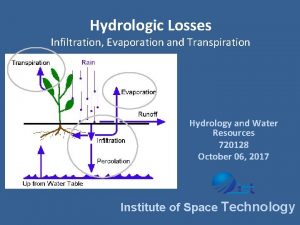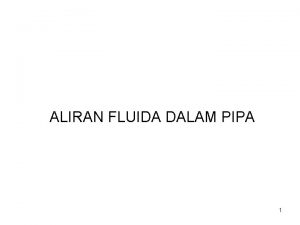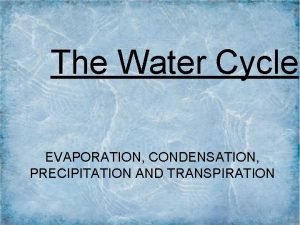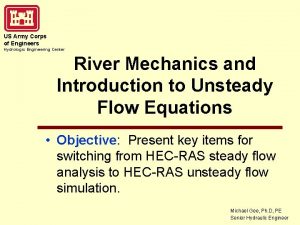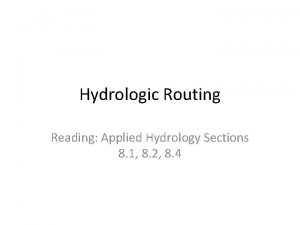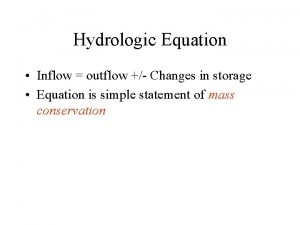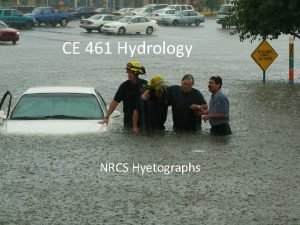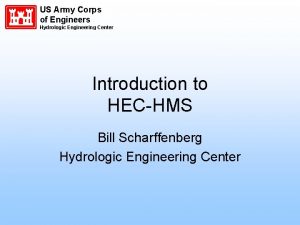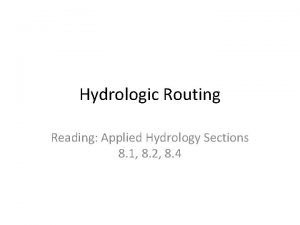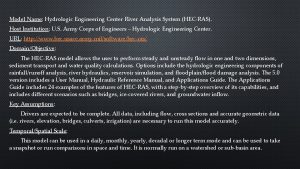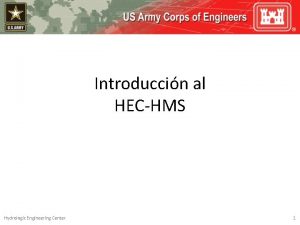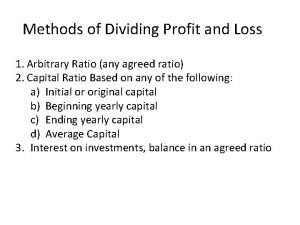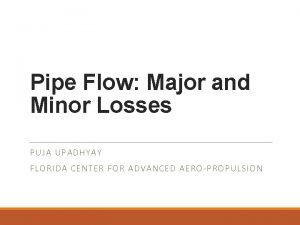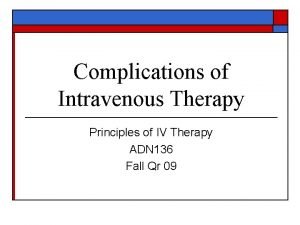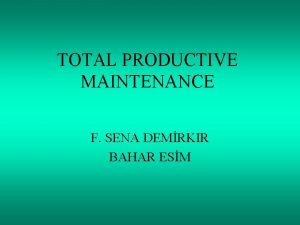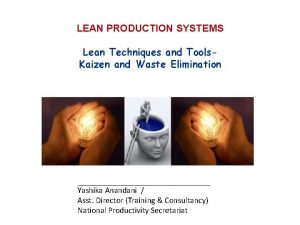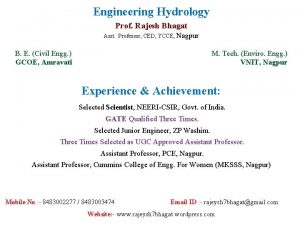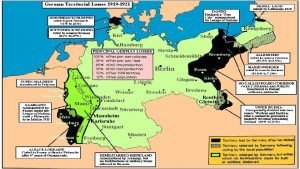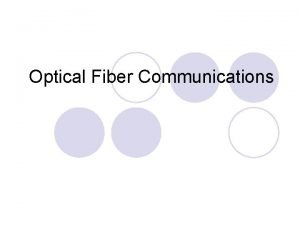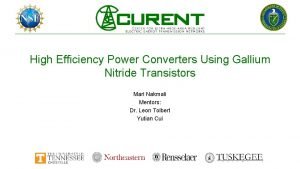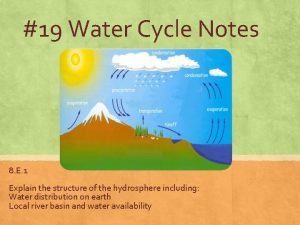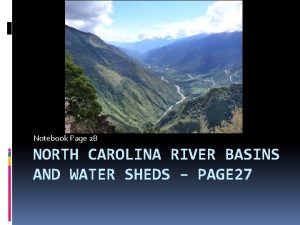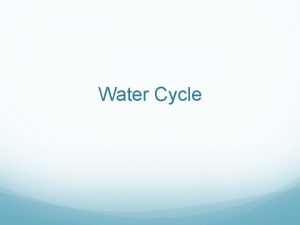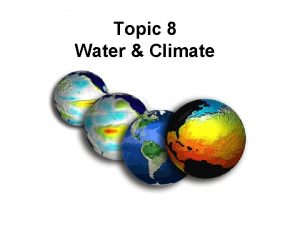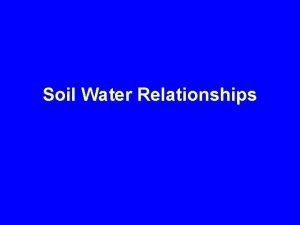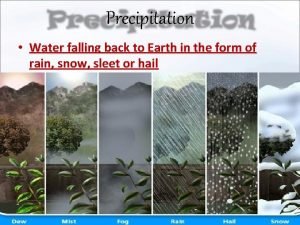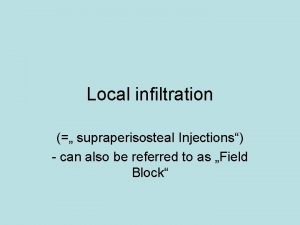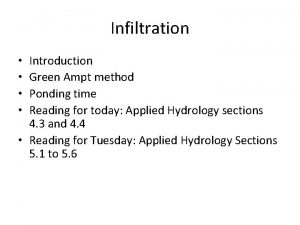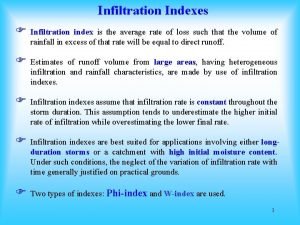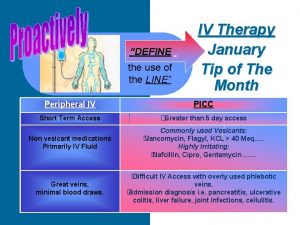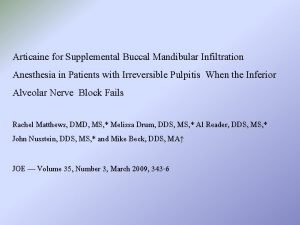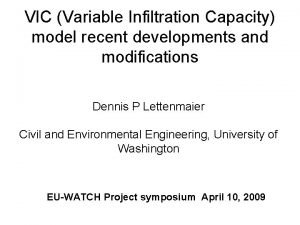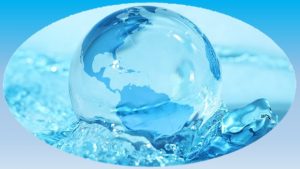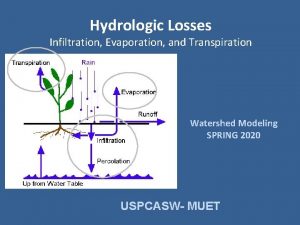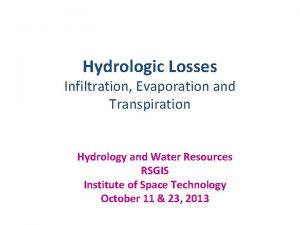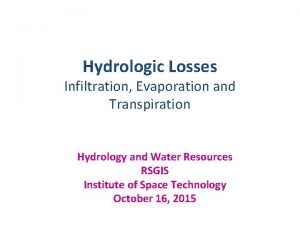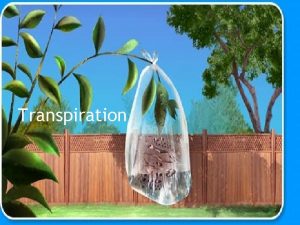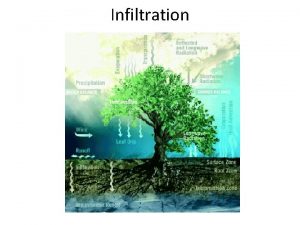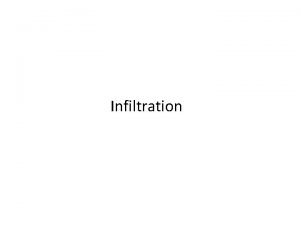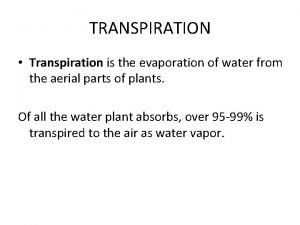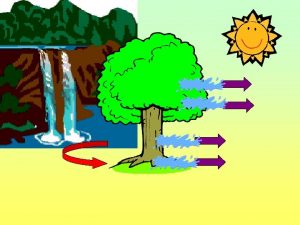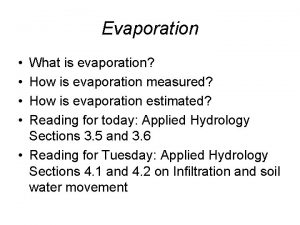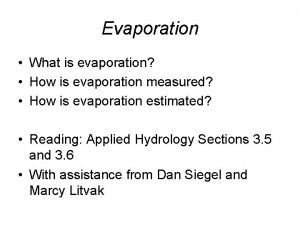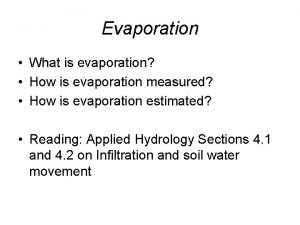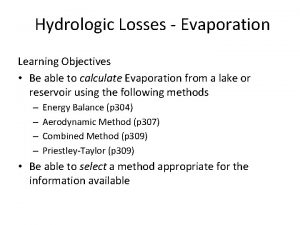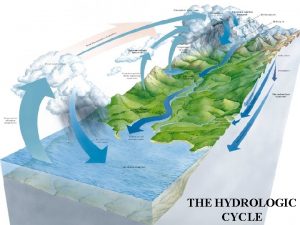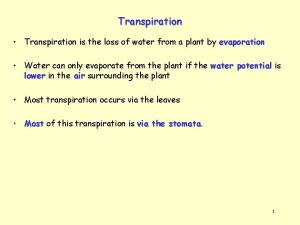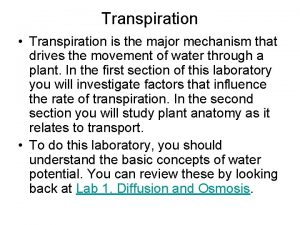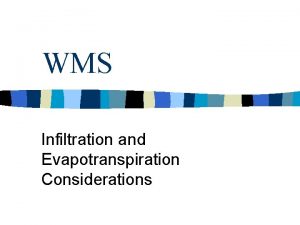Hydrologic Losses Infiltration Evaporation and Transpiration Watershed Modeling

















































- Slides: 49

Hydrologic Losses Infiltration, Evaporation and Transpiration Watershed Modeling Spring 2019 USPCASW- MUET

Learning Outcomes • After this lecture student will – KNOW – what is meant by hydrologic losses? – LEARN – how the hydrologic losses can be measured?

• Infiltration – Water moving downward into soil by crossing the soil surface through pore spaces of permeable rock or soil • Percolation – Water moving through soil (movement within the soil profile)

• Seepage – Water moving out of soil

• Zone of Aeration: Region in the ground in which pore spaces are filled with air. • Zone of Saturation: Region in the ground in which pore spaces are filled with water. • Water table: The interface between the zone of saturation and the zone of aeration. • Capillarity: The upward movement of water through very small pore spaces.


Infiltration • Infiltration depends on – Soil surface condition • Soil moisture condition • Vegetation providing channelization through roots • Compaction, cracks, urbanization, etc. – Storm conditions • Rainfall intensity and duration, etc. – Underground condition • Soil texture and transmission characteristics • Storage available underground – Others? ? ?

Infiltration Capacity – The maximum rate at which water may infiltrate into the ground is called the infiltration capacity – Differs soil to soil – Also, different for the same soil in its moist and dry states

Measurement of Infiltration 1. Ring Infiltrometer 2. Double Ring Infiltrometer 3. Sprinkler Infiltrometer

Ring Infiltrometer • Constant water level (head) in the ring is maintained by adding water to compensate the infiltration losses • Infiltration losses can be measured by keeping track of added water during time interval • Problem: water leaving out of edges (use of double ring infiltrometer)

Double Ring Infiltrometer • Water tables in both rings are maintained • Only track the water added in the inner ring • More representative of actual vertical infiltration rates

Another view By Das & Saikia

INFILTROMETERS Single Ring Double Ring http: //en. wikipedia. org/wiki/Infiltrometer

Typical Infiltration Curve

Sprinkler Infiltrometer • Relating as much as possible to the actual basin conditions

Superimposition of Rainfall Hyetograph and Infiltration Curve ?

Infiltration Indices • The average infiltration rate is called the Infiltration Index • 2 types of indices – φ – index – W – index

φ – index • Rate of infiltration above which the rainfall volume equals runoff volume • Depends on soil type, vegetative cover, initial moisture conditions, storm duration, rainfall intensity, and time of the year • If rainfall intensity is less than φ then the infiltration rate is equal to the rainfall intensity • The amount of rainfall in excess of the index is called rainfall excess or effective rainfall

φ – index

Example volume 3

Conti…. • Assume a value of phi index and calculate runoff from graph. If runoff from graph is equal to calculated runoff then phi value is correct. Otherwise assume another value of phi index and redo calculation till runoff from graph equals runoff calculated.

• Rainfall excess on hourly basis = 40/2 = 20 mm • Not equal to observed runoff • Try another value.

W – index • Average infiltration rate during the time when the rainfall intensity exceeds the infiltration rate W = Total Infiltration/ time during which the rainfall intensity exceeds the infiltration rate Total infiltration = Total precipitation – Surface runoff – Initial losses • Total infiltration is expressed as depth of water

Approximate Equations: Calculating Infiltration • • Green-Ampt Model SCS Method Horton's Model others

Green-Ampt Method (1911) • Based on Darcy’s law and unsteady continuity equation • Then integrating the differential equations F(t) =Ks t + ∆θ S ln [1 + F (t) / ∆θS] F (t) = cumulative infiltration at time t t (t) = rate of infiltration at time t Moisture deficit = ∆θ = θs- θi θi = initial water content θs= saturated water content Ks =Saturated hydraulic conductivity S = capillary suction And rate of infiltration f (t) = Ks (1 + S∆ θ / F)


Limitations • Green-Ampt model applies only when rainfall intensity > infiltration rate • For unsteady rainfall, G-A model applies as long as the rainfall variation is not large • The model would not yield correct results if there is excessive periods of low or zero rainfall. • others

SCS Method


Horton's Model (1940) • Considering exponential behavior of infiltration • Following equation was developed for finding rate curve of infiltration capacity f(t) at any time t (hr) f(t) = fc + (f 0 + fc)e-kt • f 0 = infiltration rate just at the beginning of rainfall (mm/hr) • fc = steady state infiltration capacity (mm/hr) • k = Horton’s infiltration constant dependent on vegetative cover and type of soil (hr-1)

Horton's Infiltration Curve

Typical Values of Parameters Used in Horton's Equation



Evapotranspiration (ET) • Evaporation: – Change of liquid to vapor from soil or water surface • Transpiration: – Change of liquid to vapor from surface of plant Evapotranspiration= Evaporation + Transpiration

Evaporation • Depends on: – Solar radiation – Temperature of water and air – Difference in vapor pressure between water and the overlying air – Wind speed – ….

Estimating Evaporation • • Water Budget (mass balance) Field Measurement (Pan Evaporation) Diffusion (mass transfer) Energy Budget

Water Budget Method • • Σ inflows – Σ outflows= Δ Storage Measure inflows Determine all outflows other than Evaporation and change in storage Calculate Evaporation E = – ΔS + I + P – O – GW Where: – ΔS = change in storage O= surface Outflow – I = surface Inflow P = Precipitation – GW= subsurface seepage to groundwater

Open Pan Evaporation • Simple and inexpensive • Cylindrical vessel of 1. 2 to 1. 8 m diameter, 0. 3 m high with open top made of galvanized iron • Depth of evaporation during any time interval is measured as the drop in water level in the pan (corrected for precipitation) • Water level is maintained in the pan • Observation taken on daily basis • Pan reading may be different from actual reading because of the differences in temperatures and vapor pressures between pan water and lake water Actual evaporation = pan coefficient x pan evaporation

Factors Affecting Transpiration • Plant Factor – Efficiency of root system to absorb moisture – Leaf area and structure • Soil Factor – Amount of moisture in soil • Climate Factor – Solar radiation – Atmospheric pressure, temperature and wind – Etc.

Evapotranspiration (ET) • ET rates depends on – Humidity (ET increases with decrease in Humidity) – Temperatures – Sunshine – Wind – Moisture available – Vegetation type and coverage

Potential Evapotranpiration (PET) • For given atmospheric conditions, it is the maximum ET rate possible • The real evapotranspiration occurring in a specific situation is called Actual Evapotranspiration (AET) AET < PET

• Field Capacity: maximum quantity of water that soil can retain against the force of gravity • Permanent Wilting Point: moisture content of soil at which the moisture is no longer available in sufficient quantity to sustain the plants Both depends on soil characteristics • The difference between these two moisture contents is called ‘available water’- the moisture available for plant growth

Measurement of Evapotranspiration (Field Methods) • • • Water Budget Method Soil Moisture Depletion studies Lysimeters Field Plots Using remotely sensed data from satellites to evaluate ET over vast areas (SEBAL Model – Energy Balance)

Soil Moisture Depletion Studies • Soil moisture depletion studies are made • Large number of samples are taken from various depths in the roots zone through out the growth period of a crop M 1 i and M 2 i are soil moisture % in the ith layer at the time of 1 st and 2 nd sampling respectively Gi = apparent specific gravity of ith layer of the soil Di = depth of ith layer of the soil (mm) within the root zone n = number of soil layers considered in the entire root zone

Lysimeters • Special watertight tank containing block of soil • Set into the field of growing plants • Plants growing inside the Lysimeter are same as growing in the surrounding • Evapotranspiration is estimated in term of amount of water required to maintain constant moisture conditions in the tank

Field Plots • In special plots, all elements of water budget are measured and Evapotranspiration is calculated ET=[Precipitation + Irrigation Input – runoff –increase in soil storage groundwater loss] • Groundwater loss is difficult to measure and can be minimized by keeping the moisture condition of the plot at field capacity.

Evapotranspiration Equations • Surface Energy Balanced approach

QUESTIONS? ?
 Hydrologic losses
Hydrologic losses Contoh aliran dalam pipa
Contoh aliran dalam pipa Evaporation is when
Evaporation is when Gambar transpirasi
Gambar transpirasi Helen c. erickson nursing theory
Helen c. erickson nursing theory Hydrologic continuity equation
Hydrologic continuity equation Dimensional modeling vs relational modeling
Dimensional modeling vs relational modeling Hydrologic engineering center
Hydrologic engineering center Flood routing
Flood routing Hydrologic routing
Hydrologic routing Hydrologic equation
Hydrologic equation Hydrologic abstractions
Hydrologic abstractions Objectiveable
Objectiveable Continuity equation hydraulics
Continuity equation hydraulics Hydrologic engineering center
Hydrologic engineering center Water cycle the hydrologic cycle
Water cycle the hydrologic cycle Hydrograph
Hydrograph Hydrologic engineering center
Hydrologic engineering center Hydrologic engineering center
Hydrologic engineering center Arbitrary ratio meaning
Arbitrary ratio meaning Friction factor for laminar flow
Friction factor for laminar flow Set off and carry forward of losses notes
Set off and carry forward of losses notes Iv occlusion signs
Iv occlusion signs Tpm tqm
Tpm tqm Poka yoke
Poka yoke Zhu zhu kaizen
Zhu zhu kaizen Nonrecaptured section 1231 losses
Nonrecaptured section 1231 losses Khosla formula for runoff
Khosla formula for runoff Macro bending losses in optical fiber
Macro bending losses in optical fiber German territorial losses
German territorial losses Types of optics
Types of optics Leah vinput
Leah vinput Process losses in teams
Process losses in teams Disenfranchised grief losses
Disenfranchised grief losses Water cycle and transpiration
Water cycle and transpiration Difference between watershed and river basin
Difference between watershed and river basin Condensation in the water cycle
Condensation in the water cycle Mountain humidity
Mountain humidity Soil texture water holding capacity
Soil texture water holding capacity Infiltration vs percolation
Infiltration vs percolation Buccal infiltration
Buccal infiltration Infiltration process
Infiltration process Green-ampt method excel
Green-ampt method excel Infiltration indices
Infiltration indices Iv infiltration stages
Iv infiltration stages Infiltration def water cycle
Infiltration def water cycle Buccal infiltration
Buccal infiltration Variable infiltration capacity
Variable infiltration capacity Groundwater system
Groundwater system Infiltration is
Infiltration is
